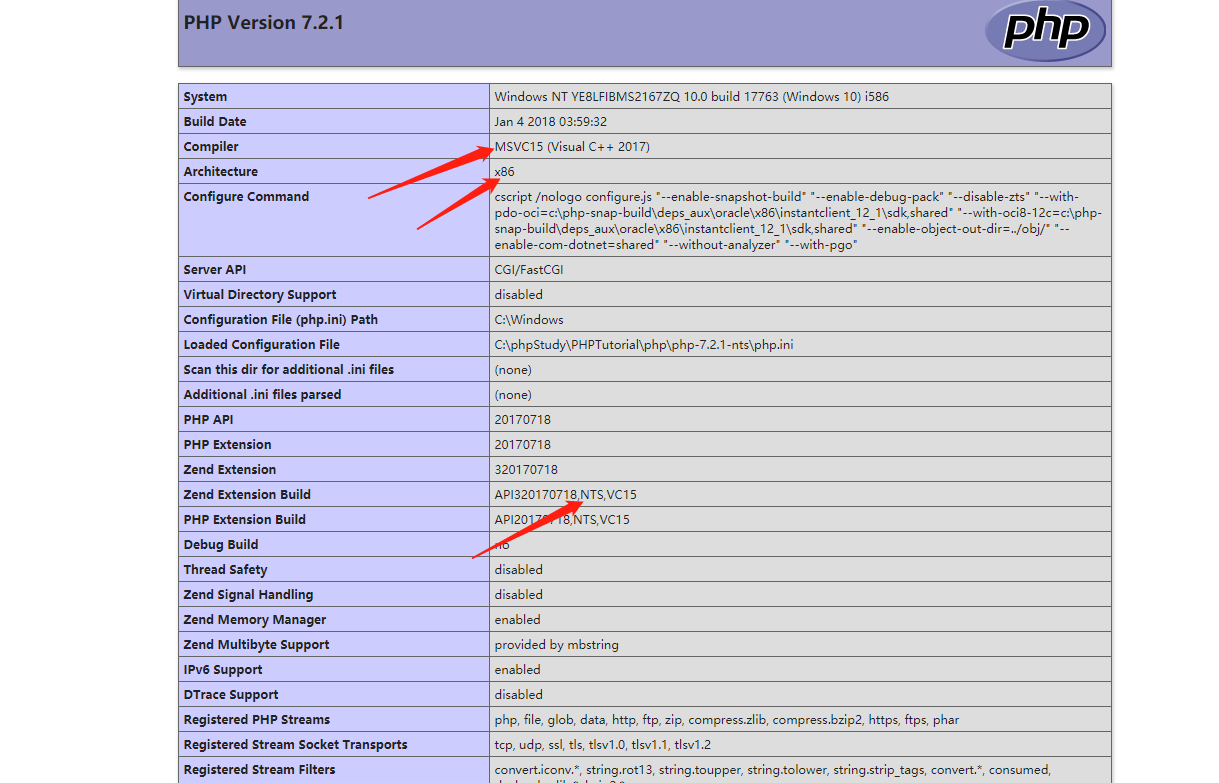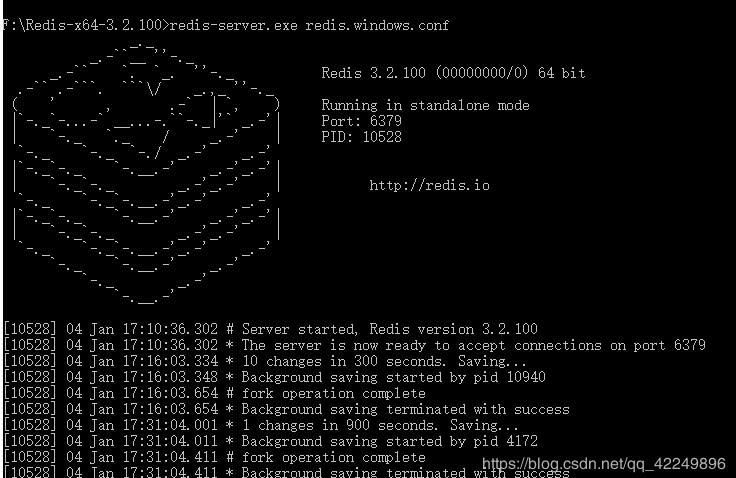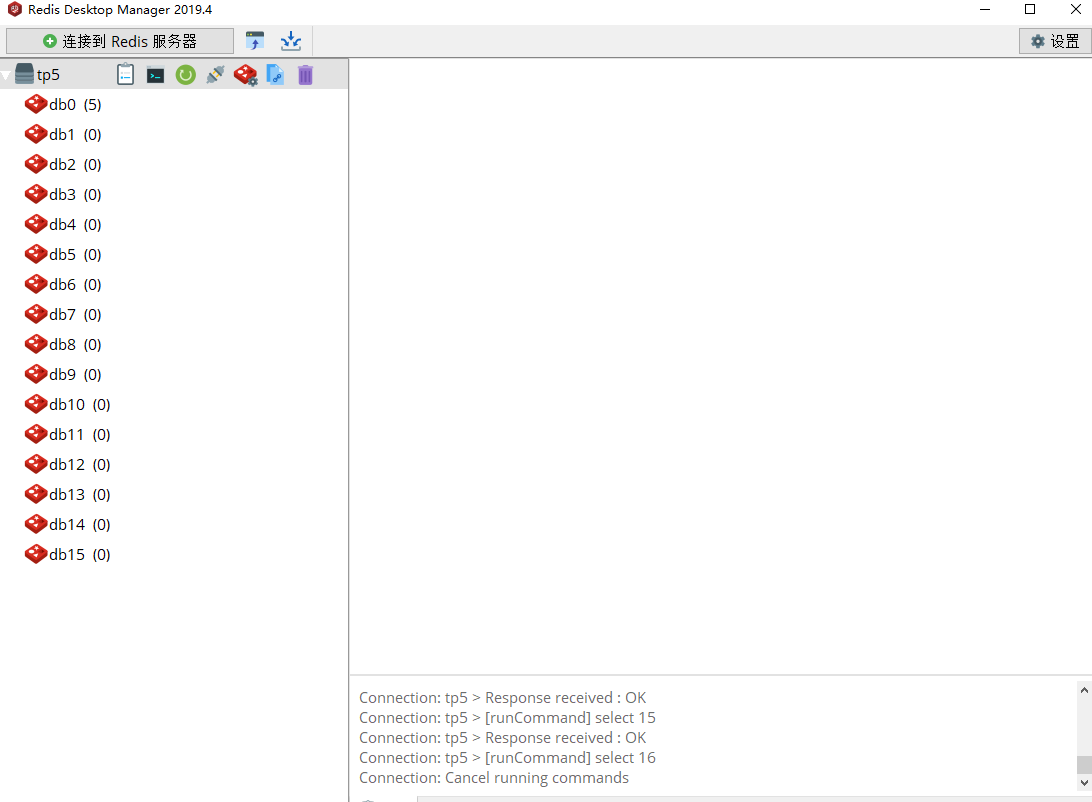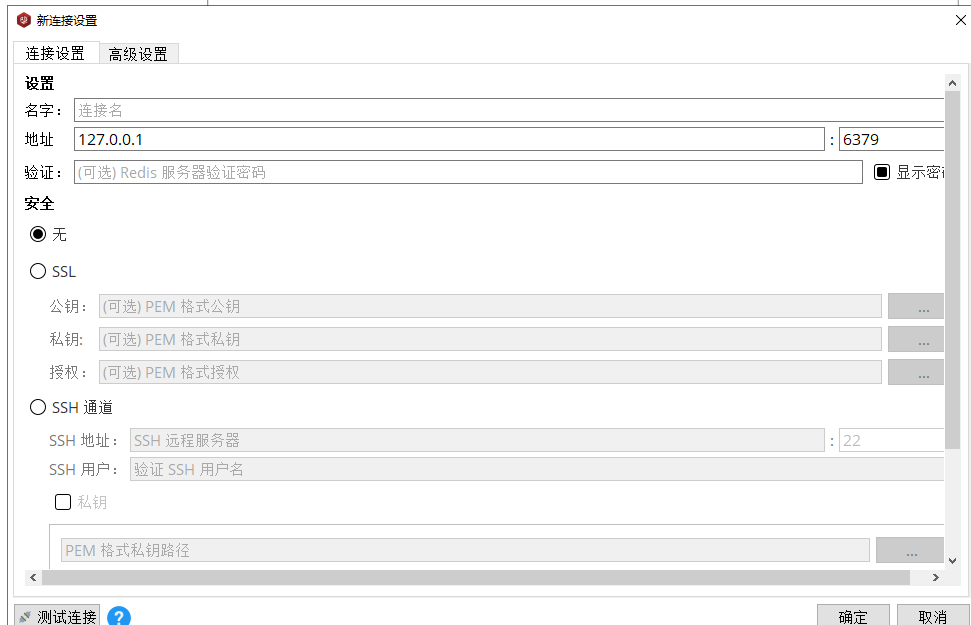# 安装redis
## php中安装redis
下载redis:[https://windows.php.net/downloads/pecl/releases/redis/](https://windows.php.net/downloads/pecl/releases/redis/)
* * *
根据自己的电脑以及php版本的信息来下载不同的redis版本:
phpinfo.php中查看自己的版本信息:

解压后:

把`php_redis.dll`和`php_redis.pdb`拷贝到`D:\phpStudy\php\php-7.2.1-nts\ext`(每个人的目录都不一样)。只用了这两个文件,别的都扔掉了。
打开php.ini:
把`extension=php_igbinary.dll和extension=php_redis.dll`拷贝到php.ini当中
**切记 把`extension=php_igbinary.dll 放在extension=php_redis.dll`的前面**
# windows系统安装redis
[https://github.com/MicrosoftArchive/redis/releases](https://github.com/MicrosoftArchive/redis/releases)
解压到目录下
使用命令行cd到该文件夹里:(使用`redis-serve.exe redis.windows.conf`来查看详细配置信息)命令行复制可能不管用 , 用手打

出现以上界面说明开启了
每次启动时都开启
**如果设置开启自启动可以避免**
# tp5引用redis缓存
在控制器中引用即可:`use think\cache\driver\Redis`
```
$redis \= new Redis();
$redis\-\>set('test','hello world');
$result\=$redis\-\>get('test');
print\_r($result);die;
```
# redisDesktop桌面可视化管理
[https://www.7down.com/soft/233274.html](https://www.7down.com/soft/233274.html)

![]
在tp5中查看参数
(images/screenshot_1584414279346.png)
# redis 常用命令
Redis是一个开源的使用ANSI C语言编写、支持网络、可基于内存亦可持久化的日志型、Key-Value数据库,并提供多种语言的API。
设置redis 密码
~~~
vi /usr/local/redis/etc/redis.conf
500 行左右
requirepass 123456
~~~
Redis支持的数据类型有 Stirng(字符串), List(列表), Hash(字典), Set(集合), Sorted Set(有序集合);
连接:
~~~
//实例化redis
$redis = new Redis();
//连接
$redis->connect('127.0.0.1', 6379);
//检测是否连接成功
echo "Server is running: " . $redis->ping();
// 输出结果 Server is running: +PONG
~~~
Strng(字符串):
~~~
// 设置一个字符串的值
$redis->set('cat', 111);
//获取一个字符串的值
echo $redis->get('cat'); // 111
// 重复set
$redis->set('cat', 222);
echo $redis->get('cat'); // 222
~~~
List(列表):
~~~
//存储数据到列表中
$redis->lpush('list', 'html');
$redis->lpush('list', 'css');
$redis->lpush('list', 'php');
//获取列表中所有的值
$list = $redis->lrange('list', 0, -1);
print_r($list);echo '<br>';
//从右侧加入一个
$redis->rpush('list', 'mysql');
$list = $redis->lrange('list', 0, -1);
print_r($list);echo '<br>';
//从左侧弹出一个
$redis->lpop('list');
$list = $redis->lrange('list', 0, -1);
print_r($list);echo '<br>';
//从右侧弹出一个
$redis->rpop('list');
$list = $redis->lrange('list', 0, -1);
print_r($list);echo '<br>';
// 结果
// Array ( [0] => php [1] => css [2] => html )
// Array ( [0] => php [1] => css [2] => html [3] => mysql )
// Array ( [0] => css [1] => html [2] => mysql )
// Array ( [0] => css [1] => html )
~~~
~~~
<?php
//实例化redis
$redis = new Redis();
//连接
$redis->connect('127.0.0.1', 6379);
//列表
//存储数据到列表中
$redis->lpush('list', 'html');
$redis->lpush('list', 'css');
$redis->lpush('list', 'php');
$redis->lpush('list', 'mysql');
$redis->lpush('list', 'javascript');
$redis->lpush('list', 'ajax');
//获取列表中所有的值
$list = $redis->lrange('list', 0, -1);
print_r($list);echo '<br>';
//获取列表的长度
$length = $redis->lsize('list');
echo $length;echo '<br>';
//返回列表key中index位置的值
echo $redis->lget('list', 2);echo '<br>';
echo $redis->lindex('list', 2);echo '<br>';
//设置列表中index位置的值
echo $redis->lset('list', 2, 'linux');echo '<br>';
$list = $redis->lrange('list', 0, -1);
print_r($list);echo '<br>';
//返回key中从start到end位置间的元素
$list = $redis->lrange('list', 0, 2);
print_r($list);echo '<br>';
$list = $redis->lgetrange('list', 0, 2);
print_r($list);echo '<br>';
//截取链表中start到end的元素
//截取列表后列表发生变化,列表保留截取的元素,其余的删除
$list = $redis->ltrim('list', 0, 1);
print_r($list);echo '<br>';
$list = $redis->lrange('list', 0, -1);
print_r($list);echo '<br>';
// 结果
// Array ( [0] => ajax [1] => javascript [2] => mysql [3] => php [4] => css [5] => html )
// 6
// mysql
// mysql
// 1
// Array ( [0] => ajax [1] => javascript [2] => linux [3] => php [4] => css [5] => html )
// Array ( [0] => ajax [1] => javascript [2] => linux )
// Array ( [0] => ajax [1] => javascript [2] => linux )
// 1
// Array ( [0] => ajax [1] => javascript )
~~~
~~~
<?php
//实例化redis
$redis = new Redis();
//连接
$redis->connect('127.0.0.1', 6379);
//列表
//存储数据到列表中
$redis->lpush('list', 'html');
$redis->lpush('list', 'html');
$redis->lpush('list', 'html');
$redis->lpush('list', 'css');
$redis->lpush('list', 'php');
$redis->lpush('list', 'mysql');
$redis->lpush('list', 'javascript');
$redis->lpush('list', 'html');
$redis->lpush('list', 'html');
$redis->lpush('list', 'html');
$redis->lpush('list', 'ajax');
//获取列表中所有的值
$list = $redis->lrange('list', 0, -1);
print_r($list);echo '<br>';
//删除列表中count个值为value的元素
//从左向右删
$redis->lrem('list', 'html', 2);
$list = $redis->lrange('list', 0, -1);
print_r($list);echo '<br>';
//从右向左删
$redis->lrem('list', 'html', -2);
$list = $redis->lrange('list', 0, -1);
print_r($list);echo '<br>';
//删除所有
$redis->lrem('list', 'html', 0);
$list = $redis->lrange('list', 0, -1);
print_r($list);echo '<br>';
// 结果
// Array ( [0] => ajax [1] => html [2] => html [3] => html [4] => javascript [5] => mysql [6] => php [7] => css [8] => html [9] => html [10] => html )
// Array ( [0] => ajax [1] => html [2] => javascript [3] => mysql [4] => php [5] => css [6] => html [7] => html [8] => html )
// Array ( [0] => ajax [1] => html [2] => javascript [3] => mysql [4] => php [5] => css [6] => html )
// Array ( [0] => ajax [1] => javascript [2] => mysql [3] => php [4] => css )
~~~
Hash(字典):
~~~
<?php
//实例化redis
$redis = new Redis();
//连接
$redis->connect('127.0.0.1', 6379);
//字典
//给hash表中某个key设置value
//如果没有则设置成功,返回1,如果存在会替换原有的值,返回0,失败返回0
echo $redis->hset('hash', 'cat', 'cat');echo '<br>';
echo $redis->hset('hash', 'cat', 'cat');echo '<br>';
echo $redis->hset('hash', 'cat', 'cat1');echo '<br>';
echo $redis->hset('hash', 'dog', 'dog');echo '<br>';
echo $redis->hset('hash', 'bird', 'bird');echo '<br>';
echo $redis->hset('hash', 'monkey', 'monkey');echo '<br>';
//获取hash中某个key的值
echo $redis->hget('hash', 'cat');echo '<br>';
//获取hash中所有的keys
$arr = $redis->hkeys('hash');
print_r($arr);echo '<br>';
//获取hash中所有的值 顺序是随机的
$arr = $redis->hvals('hash');
print_r($arr);echo '<br>';
//获取一个hash中所有的key和value 顺序是随机的
$arr = $redis->hgetall('hash');
print_r($arr);echo '<br>';
//获取hash中key的数量
echo $redis->hlen('hash');echo '<br>';
//删除hash中一个key 如果表不存在或key不存在则返回false
echo $redis->hdel('hash', 'dog');echo '<br>';
var_dump($redis->hdel('hash', 'rabbit'));echo '<br>';
// 结果
// 1
// 0
// 0
// 1
// 1
// 1
// cat1
// Array ( [0] => cat [1] => dog [2] => bird [3] => monkey )
// Array ( [0] => cat1 [1] => dog [2] => bird [3] => monkey )
// Array ( [cat] => cat1 [dog] => dog [bird] => bird [monkey] => monkey )
// 4
// 1
// int(0)
~~~
~~~
<?php
//实例化redis
$redis = new Redis();
//连接
$redis->connect('127.0.0.1', 6379);
//字典
//批量设置多个key的值
$arr = [1=>1, 2=>2, 3=>3, 4=>4, 5=>5];
$redis->hmset('hash', $arr);
print_r($redis->hgetall('hash'));echo '<br>';
// 批量获得额多个key的值
$arr = [1, 2, 3, 5];
$hash = $redis->hmget('hash', $arr);
print_r($hash);echo '<br>';
//检测hash中某个key知否存在
echo $redis->hexists('hash', '1');echo '<br>';
var_dump($redis->hexists('hash', 'cat'));echo '<br>';
print_r($redis->hgetall('hash'));echo '<br>';
//给hash表中key增加一个整数值
$redis->hincrby('hash', '1', 1);
print_r($redis->hgetall('hash'));echo '<br>';
//给hash中的某个key增加一个浮点值
$redis->hincrbyfloat('hash', 2, 1.3);
print_r($redis->hgetall('hash'));echo '<br>';
//结果
// Array ( [1] => 1 [2] => 2 [3] => 3 [4] => 4 [5] => 5 )
// Array ( [1] => 1 [2] => 2 [3] => 3 [5] => 5 )
// 1
// bool(false)
// Array ( [1] => 1 [2] => 2 [3] => 3 [4] => 4 [5] => 5 )
// Array ( [1] => 2 [2] => 2 [3] => 3 [4] => 4 [5] => 5 )
// Array ( [1] => 2 [2] => 3.3 [3] => 3 [4] => 4 [5] => 5 )
~~~
Set(集合):
~~~
<?php
//实例化redis
$redis = new Redis();
//连接
$redis->connect('127.0.0.1', 6379);
//集合
// 添加一个元素
echo $redis->sadd('set', 'cat');echo '<br>';
echo $redis->sadd('set', 'cat');echo '<br>';
echo $redis->sadd('set', 'dog');echo '<br>';
echo $redis->sadd('set', 'rabbit');echo '<br>';
echo $redis->sadd('set', 'bear');echo '<br>';
echo $redis->sadd('set', 'horse');echo '<br>';
// 查看集合中所有的元素
$set = $redis->smembers('set');
print_r($set);echo '<br>';
//删除集合中的value
echo $redis->srem('set', 'cat');echo '<br>';
var_dump($redis->srem('set', 'bird'));echo '<br>';
$set = $redis->smembers('set');
print_r($set);echo '<br>';
//判断元素是否是set的成员
var_dump($redis->sismember('set', 'dog'));echo '<br>';
var_dump($redis->sismember('set', 'bird'));echo '<br>';
//查看集合中成员的数量
echo $redis->scard('set');echo '<br>';
//移除并返回集合中的一个随机元素(返回被移除的元素)
echo $redis->spop('set');echo '<br>';
print_r($redis->smembers('set'));echo '<br>';
// 结果
// 1
// 0
// 1
// 1
// 1
// 1
// Array ( [0] => rabbit [1] => cat [2] => bear [3] => dog [4] => horse )
// 1
// int(0)
// Array ( [0] => dog [1] => rabbit [2] => horse [3] => bear )
// bool(true)
// bool(false)
// 4
// bear
// Array ( [0] => dog [1] => rabbit [2] => horse )
~~~
~~~
<?php
//实例化redis
$redis = new Redis();
//连接
$redis->connect('127.0.0.1', 6379);
//集合
$redis->sadd('set', 'horse');
$redis->sadd('set', 'cat');
$redis->sadd('set', 'dog');
$redis->sadd('set', 'bird');
$redis->sadd('set2', 'fish');
$redis->sadd('set2', 'dog');
$redis->sadd('set2', 'bird');
print_r($redis->smembers('set'));echo '<br>';
print_r($redis->smembers('set2'));echo '<br>';
//返回集合的交集
print_r($redis->sinter('set', 'set2'));echo '<br>';
//执行交集操作 并结果放到一个集合中
$redis->sinterstore('output', 'set', 'set2');
print_r($redis->smembers('output'));echo '<br>';
//返回集合的并集
print_r($redis->sunion('set', 'set2'));echo '<br>';
//执行并集操作 并结果放到一个集合中
$redis->sunionstore('output', 'set', 'set2');
print_r($redis->smembers('output'));echo '<br>';
//返回集合的差集
print_r($redis->sdiff('set', 'set2'));echo '<br>';
//执行差集操作 并结果放到一个集合中
$redis->sdiffstore('output', 'set', 'set2');
print_r($redis->smembers('output'));echo '<br>';
// 结果
// Array ( [0] => cat [1] => dog [2] => bird [3] => horse )
// Array ( [0] => bird [1] => dog [2] => fish )
// Array ( [0] => bird [1] => dog )
// Array ( [0] => dog [1] => bird )
// Array ( [0] => cat [1] => dog [2] => bird [3] => horse [4] => fish )
// Array ( [0] => cat [1] => dog [2] => bird [3] => horse [4] => fish )
// Array ( [0] => horse [1] => cat )
// Array ( [0] => horse [1] => cat )
~~~
Sorted Set(有序集合):
~~~
<?php
//实例化redis
$redis = new Redis();
//连接
$redis->connect('127.0.0.1', 6379);
//有序集合
//添加元素
echo $redis->zadd('set', 1, 'cat');echo '<br>';
echo $redis->zadd('set', 2, 'dog');echo '<br>';
echo $redis->zadd('set', 3, 'fish');echo '<br>';
echo $redis->zadd('set', 4, 'dog');echo '<br>';
echo $redis->zadd('set', 4, 'bird');echo '<br>';
//返回集合中的所有元素
print_r($redis->zrange('set', 0, -1));echo '<br>';
print_r($redis->zrange('set', 0, -1, true));echo '<br>';
//返回元素的score值
echo $redis->zscore('set', 'dog');echo '<br>';
//返回存储的个数
echo $redis->zcard('set');echo '<br>';
//删除指定成员
$redis->zrem('set', 'cat');
print_r($redis->zrange('set', 0, -1));echo '<br>';
//返回集合中介于min和max之间的值的个数
print_r($redis->zcount('set', 3, 5));echo '<br>';
//返回有序集合中score介于min和max之间的值
print_r($redis->zrangebyscore('set', 3, 5));echo '<br>';
print_r($redis->zrangebyscore('set', 3, 5, ['withscores'=>true]));echo '<br>';
//返回集合中指定区间内所有的值
print_r($redis->zrevrange('set', 1, 2));echo '<br>';
print_r($redis->zrevrange('set', 1, 2, true));echo '<br>';
//有序集合中指定值的socre增加
echo $redis->zscore('set', 'dog');echo '<br>';
$redis->zincrby('set', 2, 'dog');
echo $redis->zscore('set', 'dog');echo '<br>';
//移除score值介于min和max之间的元素
print_r($redis->zrange('set', 0, -1, true));echo '<br>';
print_r($redis->zremrangebyscore('set', 3, 4));echo '<br>';
print_r($redis->zrange('set', 0, -1, true));echo '<br>';
//结果
// 1
// 0
// 0
// 0
// 0
// Array ( [0] => cat [1] => fish [2] => bird [3] => dog )
// Array ( [cat] => 1 [fish] => 3 [bird] => 4 [dog] => 4 )
// 4
// 4
// Array ( [0] => fish [1] => bird [2] => dog )
// 3
// Array ( [0] => fish [1] => bird [2] => dog )
// Array ( [fish] => 3 [bird] => 4 [dog] => 4 )
// Array ( [0] => bird [1] => fish )
// Array ( [bird] => 4 [fish] => 3 )
// 4
// 6
// Array ( [fish] => 3 [bird] => 4 [dog] => 6 )
// 2
// Array ( [dog] => 6 )
~~~
